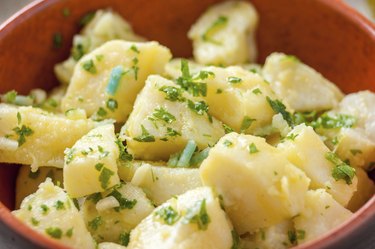
The potato can make you feel at home in any part of the world. According to the International Potato Center, the potato is the third most grown crop in the world, with more than 300 million metric tons produced annually. The United Nations declared 2008 as the International Year of the Potato because of its importance in feeding the poor and hungry. If not deep-fried and loaded with butter or cheese, potatoes have a lot to offer nutritionally, and they are easy to digest as well.
Nutrition Facts
Video of the Day
Potatoes come in many shapes, sizes, and colors. The food label states that a 5.3-ounce potato is totally free of fat and sodium. It provides 110 calories, and with the skin on, contains 620 milligrams of potassium and 27 milligrams of vitamin C. Potatoes also contain some of the B vitamins, calcium and iron. According to the International Potato Center, one serving of boiled potatoes with skin provides 10 percent of fiber and half the requirement for vitamin C.
Video of the Day
Start of Digestion
The process of digestion of the carbohydrate-rich boiled potato begins when you start chewing. Salivary amylase, an enzyme secreted with the saliva, acts on the long polysaccharide units that make up starch, to form disaccharides called maltose. The action of salivary amylase continues until the potato reaches the stomach. The acidic digestive juices in the stomach stop enzyme activity. The potato is now a mass of disaccharides and any polysaccharides that were not broken down by the salivary amylase.
Completion of Digestion
Upon entering the small intestine, any remaining polysaccharides are broken down into disaccharides by the enzyme pancreatic amylase. All the disaccharides are further broken down into monosaccharides, or single units of glucose, for absorption. The enzyme maltase, present on the surface of the small intestine, splits the maltose into two molecules of glucose. The digestive enzymes cannot break the fiber in the potato, so it becomes part of the undigested food in the large intestine.
Source of Energy
The potato becomes a source of energy when the intestinal cells absorb the glucose, which enters the blood stream and travels to the liver. Some glucose circulates in the blood to maintain blood glucose levels. The body uses the rest for cells and physical activity. After meeting energy needs, any extra glucose stores in the liver as glycogen.